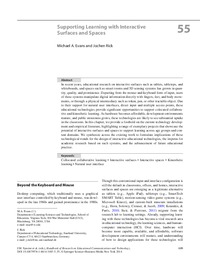Supporting Learning with Interactive Surfaces and SpacesMichael A. Evans, Jochen Rick
Zu finden in: Handbook of Research on Educational Communications and Technology (Seite 689 bis 701), 2014
|
 |
 Diese Seite wurde seit 3 Jahren inhaltlich nicht mehr aktualisiert.
Unter Umständen ist sie nicht mehr aktuell.
Diese Seite wurde seit 3 Jahren inhaltlich nicht mehr aktualisiert.
Unter Umständen ist sie nicht mehr aktuell.
 Zusammenfassungen
Zusammenfassungen
 In recent years, educational research on interactive surfaces such as tablets, tabletops, and whiteboards, and spaces such as smart rooms and 3D sensing systems has grown in quantity, quality, and prominence. Departing from the mouse-and-keyboard form of input, users of these systems manipulate digital information directly with fingers, feet, and body movements, or through a physical intermediary such as token, pen, or other tractable object. Due to their support for natural user interfaces, direct input and multiple access points, these educational technologies provide significant opportunities to support colocated collaborative and kinesthetic learning. As hardware becomes affordable, development environments mature, and public awareness grows, these technologies are likely to see substantial uptake in the classroom. In this chapter, we provide a foothold on the current technology development and empirical literature, highlighting a range of exemplary projects that showcase the potential of interactive surfaces and spaces to support learning across age groups and content domains. We synthesize across the existing work to formulate implications of these technological trends for the design of interactive educational technologies, the impetus for academic research based on such systems, and the advancement of future educational practice.
In recent years, educational research on interactive surfaces such as tablets, tabletops, and whiteboards, and spaces such as smart rooms and 3D sensing systems has grown in quantity, quality, and prominence. Departing from the mouse-and-keyboard form of input, users of these systems manipulate digital information directly with fingers, feet, and body movements, or through a physical intermediary such as token, pen, or other tractable object. Due to their support for natural user interfaces, direct input and multiple access points, these educational technologies provide significant opportunities to support colocated collaborative and kinesthetic learning. As hardware becomes affordable, development environments mature, and public awareness grows, these technologies are likely to see substantial uptake in the classroom. In this chapter, we provide a foothold on the current technology development and empirical literature, highlighting a range of exemplary projects that showcase the potential of interactive surfaces and spaces to support learning across age groups and content domains. We synthesize across the existing work to formulate implications of these technological trends for the design of interactive educational technologies, the impetus for academic research based on such systems, and the advancement of future educational practice. Dieses Kapitel erwähnt ...
Dieses Kapitel erwähnt ...
 Zitationsgraph (Beta-Test mit vis.js)
Zitationsgraph (Beta-Test mit vis.js)
 1 Erwähnungen
1 Erwähnungen 
- Digitales Lehren und Lernen (Jörg Zumbach) (2021)

 Anderswo finden
Anderswo finden
 Volltext dieses Dokuments
Volltext dieses Dokuments
 |  Supporting Learning with Interactive Surfaces and Spaces: Artikel als Volltext bei Springerlink ( Supporting Learning with Interactive Surfaces and Spaces: Artikel als Volltext bei Springerlink ( : :  , 528 kByte; , 528 kByte;  : :  2020-11-28) 2020-11-28) |
 Anderswo suchen
Anderswo suchen 
 Beat und dieses Kapitel
Beat und dieses Kapitel
Beat hat Dieses Kapitel während seiner Zeit am Institut für Medien und Schule (IMS) ins Biblionetz aufgenommen. Beat besitzt kein physisches, aber ein digitales Exemplar. Eine digitale Version ist auf dem Internet verfügbar (s.o.). Aufgrund der wenigen Einträge im Biblionetz scheint er es nicht wirklich gelesen zu haben. Es gibt bisher auch nur wenige Objekte im Biblionetz, die dieses Werk zitieren.











 Biblionetz-History
Biblionetz-History